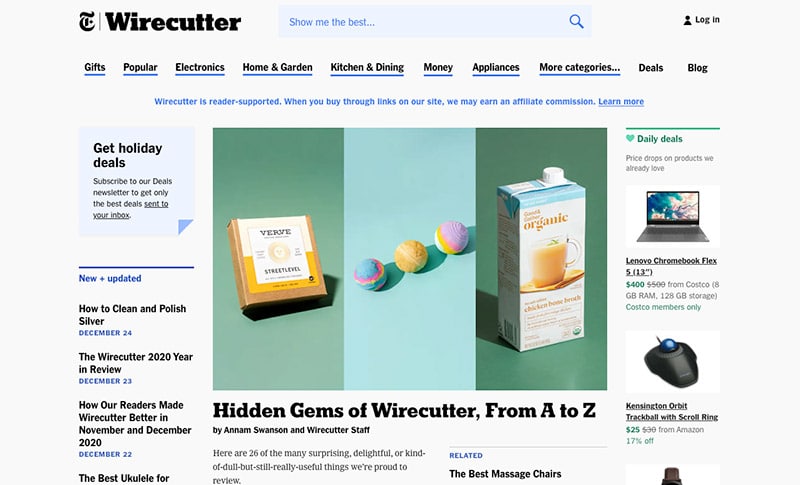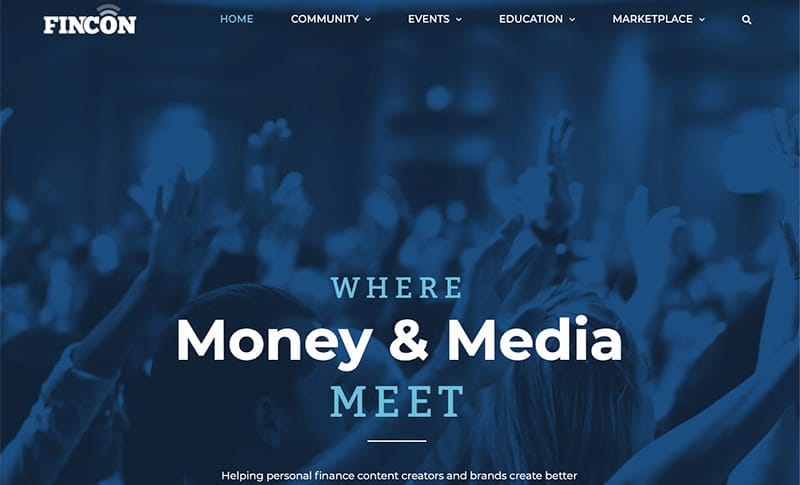How To Make Money Blogging In 2025 (8 Ways To Monetize)
Starting a blog is easy. Making money with that blog is slightly more difficult.
I have some good news and some bad news.
First, let’s get the bad news out of the way: You’re not going to make money from blogging overnight. Blogging is NOT a “get rich quick” scheme.
It will take time. Occasionally it can take only six months. But in most cases, it will be a two-year journey.
The good news: A blog can be a very profitable business. It’s great for someone who’s looking to start a side hustle. No joke, it’s possible to make five, six, and — in some cases — seven figures or more a year blogging. With hard work and a dash of luck, you could sell your blog for $6 million, as I did in 2018.
Blogging is certainly a legitimate way to make money online.
Looking to Start a Blog?
Check out my guide, How to Start a Blog and Make Money.
This post is going to be all about how to monetize your blog. I’m going to tell you some clear-cut ways to make money online. I’ll break down each option and tell you its pros and cons.
My suggestions may not work for everyone. It depends on which business niche your blog is in.
For example, my previous business was an investment blog. Most of my revenue came from affiliate marketing. However, I could have also made money from ad banners, sponsored posts, digital products, and a membership site. But selling physical products wouldn’t have worked as a viable option.
TL;DR – How to Make Money Blogging
I’ll list the ways to make money from blogging by difficulty. The first option will be the easiest, and the last will be the most difficult.
While there are some outliers, this is pretty much the definitive list of ways to make money online with a blog:
1. Consulting and Coaching

Pros: Easy to start
Cons: Like a job, you are trading time for money
The first and easiest way to make money from your blog is by trading your time for money. While I’m not a fan of this type of work for the long term, it can be a great option when you’re just starting out.
For a great example, I used Miranda Marquit to write articles on my blog Investor Junkie. She makes her income as a full-time freelance writer and consultant. Besides mine, she has written for many other personal finance blogs as well.
Another example, and friend, is Holly Johnson. Holly and her husband, Greg, make over $200,000 a year on just writing alone. They have other sources of income with their blog via affiliate marketing as well.
Typically, with coaching, you’re helping your client achieve some result. With consulting, you’re doing work for the client. However, for our purposes, we’ll consider coaching and consulting as the same kind of thing.
In fact, through my own blog, I offer consulting services. I’m in a financial position where I don’t need the income, but I would still like to help clients who can use my skills.
The downside to consulting or coaching is it’s not scalable. You need more time or to hire employees to make more money.
However, at some point, you’ll want to scale your skills and make money while you’re sleeping. Consulting doesn’t allow you to do this. You get paid only for the hours you work. It’s really no different than working at a job, except with more freedom.
So eventually, you want to turn your consulting work into a process you can sell as an online course or software as a service.
On the positive side, with freelancing, you can hang your shingle and be up and running pretty quickly. Essentially, your website is a glorified online brochure. You can use your blog as a sales and marketing tool to attract possible clients.
If you go this route with your blog, make sure you have some sort of sales funnel in place. This can be as simple as posting your email address and phone number.
These are the types of methods prospects can contact you by:
- Web signup form
- Phone number
- Social media
- Mailing list
- Address
However, I’m not a fan of posting your email address on your website. For one thing, you’ll get a ton of spam if you do so. But there’s another issue: You won’t be pre-qualifying your prospects.
The best thing to do is to use a web form to ask some basic questions about your potential customers.
I recommend WPForms for creating your web form.
2. Blog Advertisements
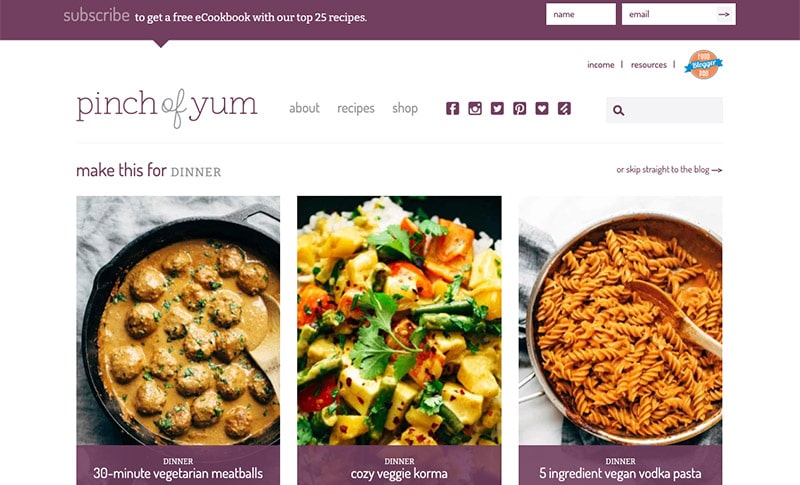
Pros: Easy to implement
Cons: Needs lots of traffic for any significant revenue. Sends visitors off your blog
Online ads can take on many shapes but are usually in the form of ad banners, buttons, videos, and text links. These ads are usually placed in your header, content, or navigation sidebar, but they can be too invasive and interrupt the user’s experience.
In its last income report, recipe site Pinch of Yum lists that it made $52,000 just from AdThrive. That’s for only one month and doesn’t include sponsored posts and affiliate marketing income.
The two primary ways to make money with online ads are:
- CPC/PPC — This is short for Cost Per Click and Pay Per Click. Every time a reader clicks on the ad, you get paid.
- CPM — Refers to Cost Per Mille (thousand) impressions. These are ads that pay you a fixed amount of money based on how many people view them.
I’m not a big fan of using online ads to make money blogging. But it’s a viable option for many folks.
Here are my grievances with online ads:
- Significant Traffic Needed — The biggest problem with a new blog is you need significant traffic (50,000 or more monthly page views) before you can start making a decent amount of money from ads.
- More Visitors Not Seeing Ads — A growing number of individuals are installing ad blockers. According to current data, 20-30% of all visitors have an ad blocker installed. This means they don’t see the ads on your blog.
- Distracting to Your Brand — This perhaps my biggest pet peeve. You’ve spent all of this effort to attract visitors and then an ad banner sends them off to another website. They may never return.
If you’re still interested in using ad banners as a way to monetize your website, you can do so via two ways:
- Ad networks
- Private placement
Ad Networks
Ad networks do all the heavy lifting for you. They manage all the ad inventory and serve the ad best suited to each visitor. The ad network gets a cut of each ad displayed on your site.
Everyone — the publisher (you), the ad network, and the merchant — benefits from this arrangement. Merchants like this arrangement because of the large number of blogs (i.e., page views) they get instant access to, instead of working out deals with individual blogs.
Some ad networks specialize in specific niches, so check first with an advertising rep to make sure your blog is a good fit. Here are some possible ad networks you can use for your blog:
Many of these ad networks require a minimum of 100,000 unique visitors per month. If you are just starting out, this is usually a big problem.
The easiest ad network to get started with is Google AdSense. If you have existing blog content, you can be up and running literally within minutes. On the plus side, AdSense doesn’t require a minimum traffic count. Unfortunately, AdSense usually generates the least amount of revenue. There are better options for making more money with CPC ads.
I consider Google AdSense to be the ad network of last resort.
The problem with ad networks is that they’re trying to maximize ad revenue. At first, this seems great! However, that revenue usually comes at the expense of your search ranking within Google. Typically, the more aggressive the ad banner — and the more of them there are! — the less likely you’ll rank for highly competitive keywords in Google.
If I were to use an ad network, I would recommend Ezoic. It is easy to set up and, unlike many other networks, has performance options to speed things up.
Private Ads
The other way to monetize your site with ads is via private ad placement. With this option, you do the work all yourself, but you have all the control. Usually, you can do this when you have a large enough website audience or are working within a very small business niche.
With private ads, you find the merchants, you set the terms and prices, you create the IO (Insert Order, in ad-speak), and you work out how to display the ads on your blog.
The most challenging part of this is managing your ad inventory. You need a way to serve up the ads to your audience.
You have three possible options:
- WordPress plugin
- Self-hosted ad server
- Hosted option
Starting with a WordPress ad plugin is your best bet if you’re just starting out. I recommend AdSanity. However, as you grow, it’s more than likely you won’t want your blog to host the ads. It slows down the loading of your blog.
If you’re technically advanced like me, you can host your own ad server. I used Revive Adserver, which is free to use. It gives you all sorts of options, such as separating the ads from the website, and it can make your blog run faster.
The last method is to use a hosted option. One such option is available for free from Google. Oddly enough, it’s called Google Ad Manager. Although it’s free and advanced, I find it unnecessarily complicated and difficult to use. So I cannot recommend using it.
Revive does happen to have a paid hosted option that I would recommend over Google Ad Manager.
3. Sponsored Post

Pros: Can use your authority to make bank
Cons: Can make you look like a sellout. May not get big returns for the amount of work
Sponsored posts are just what they sound like.
You or the merchant create an article to publish on your blog. The merchant pays you for publishing that content. That payment can be in the form of cold, hard cash, or it could be a free product. With sponsored posts, you work out the terms with the merchant.
As a package deal, you can include promoting the advertiser’s product via other media. These include your social media channels such as Facebook, Instagram, Twitter, etc. They can also include your mailing list as well.
Fit Mommy In Heels, written by blogger Lauren, is a fitness blog for stay-at-home moms. In her example, she has made over $9k in a month just from sponsored posts alone.
To get sponsored posts, you either go out and reach out to brands to see if they want to sponsor posts on your blog. The easier way, especially if you are just starting out, is to join a sponsorship network. Networks usually require a specific amount of monthly traffic or followers. So check if you meet those “influencer” requirements before you apply.
If you do a sponsored post, you are legally required (by the FTC here in the U.S.) to disclose that the article was paid for. Failure to do so puts you and the merchant at legal risk.
Also, if you do a sponsored post, make sure the links to the merchant are nofollow. Many merchants use sponsored posts as a means to help increase the number of links to their websites.
Backlinks are the lifeblood of SEO. But Google frowns upon backlinks that aren’t organically occurring — meaning, not paid for. So make sure those sponsored links are not counted. Use rel=”nofollow sponsored” in your links when linking to the merchant in the sponsored post.
When sponsored posts are done well, they are genuine and helpful to the reader. When done incorrectly, they cheapen your brand and make you look like a sellout.
The other problem with sponsored posts is that they require a certain amount of web traffic before vendors will work with you. The amount of traffic will vary based on the company. Some companies may not even care since it’s part of their ad spending budget, and they look at a sponsored post as a branding exercise.
Personally, I’m not a fan of using sponsored posts and believe they require too much effort for a small payout. If you do consider using them, plan out your course of action in detail.
4. Affiliate Marketing
Pros: Unlimited revenue potential. No products to create or support
Cons: No control over affiliate programs and how well they sell
With affiliate marketing, you promote and market another company’s products. You make money when a visitor clicks on a link and then converts.
That conversion is defined by the merchant. It can be as simple as email signup or as complex as not only opening an account but depositing money (this was the case with the financial services I worked with as Investor Junkie). Most merchants with affiliate marketing programs will credit you when a sale occurs.
The two most common methods for conversions are:
- CPL — Or Cost Per Lead. You get a commission when someone signs up to the affiliate’s mailing list. These signups may or may not become paid customers.
- CPA — Stands for Cost Per Action. You get a commission when a specific action occurs. Usually, that’s a sale, but it can be whatever the merchant defines as a successful conversion.
Unlike online ads, affiliate marketing is typically better suited for a beginner blogger with a small amount of traffic.
That’s because you get paid on the quality of conversions, not the quantity. With affiliate marketing, you make money only when a visitor converts. On the other hand, with ad banners, you make more money with more web traffic.
A beginner blogger can make significantly more money from affiliate marketing than from ad banners.
Affiliate marketing can be a six- or seven-figure-a-year business. In 2018, I sold my blog Investor Junkie for $6 million. The revenue from my blog was just from affiliate marketing. As I mentioned in the featured image, Wirecutter was sold to The New York Times for $30 million in 2016. I’ve documented all of the affiliate blogs that sold for seven figures or more.
What matters with affiliate marketing is your audience’s engagement and the relevancy of the merchant’s product. Affiliate marketing is my favorite way to make money online.
The beauty of affiliate marketing? There’s:
- No inventory
- No customer service
- No research and development
You can make money literally while you’re sleeping. If you like a product, you can start selling it on your website within a few minutes.
For more tips, check out my article on
how to become an affiliate marketer.
If you want to get started, I wrote an article to help you with the best affiliate marketing programs.
The downside to affiliate marketing is that you don’t own the product you’re offering. Affiliate marketing programs come and go, and you’re at the whim of the merchant. If the company decides to shut down its affiliate program, you lose a source of revenue.
Unfortunately, this happens more often than you think. So you must diversify using multiple affiliates and not rely on revenue from just one merchant.
5. Digital Products
Pros: Can make 100% profit with no revenue sharing with merchants. There is no inventory to manage
Cons: Others can easily replicate the products you create
The next level up is building your own digital products instead of selling someone else’s via affiliate marketing.
Digital products can be broken down into four different types:
- eBooks
- Online courses (via video, audio, or text)
- Virtual conferences
- Software (one-time purchase and download)
The nice thing about digital products is you create them once. You have no inventory, but you do have unlimited upside potential. The only limitation is your ability to market to a captive audience.
Some digital products can take more time than others. For example, a short eBook can take a few weeks to write, while a course can take three to four months or more, depending upon its length and complexity.
When I first started developing websites, it was hard to do audio and video online. Instead, you sent out audio CDs or DVDs to the customer. This required inventory that needed to be created and replenished when you ran out.
Today, for most of the marketplace (except the 65-and-over audience), everything should be sold online without a physical product.
eBooks
Instead of creating a physical book, you mail out, you deliver it online, usually via an Adobe Acrobat file. You can also do what my friend Rob Berger did. He self-published his book. Retire Before Mom and Dad: The Simple Numbers Behind a Lifetime of Financial Freedom, on Amazon.
Rob’s book is available not only via Amazon’s Kindle but also as a physical book. Amazon handles all the printing and shipping. So you have the added benefit and prestige of being known as an author.
eBooks work well because they’re relatively easier to produce than other digital products. The other advantage of writing an eBook is gaining credibility in the topic. Plus, I’ve seen eBooks that have blog content repackaged into book form.
Online Courses
With online courses, you deliver educational material electronically. This is much more scalable than consulting, coaching, or a traditional classroom environment. Teaching one person takes the same effort as teaching 10,000 people.
The other advantage is you remove the geographical location aspect of teaching. You can teach anyone, anywhere in the world at any time. If someone in Germany wants to learn how to cook the perfect blueberry pie at 2 a.m., there’s a course for them online.
The format today is typically some form of video. It can be as simple as capturing screen slides from a PowerPoint presentation with a voiceover from you. It can be as complex as you speaking in front of a professional videographer with lighting and background. You can also do audio-only and text courses, although most customers expect some form of video.
There are many aspects to online courses. They can be hosted on your blog, or if you’re just starting out, it might make sense to use an educational platform such as Teachable.
Online courses can either be prerecorded or you can use webinar software to teach the material live.
Virtual Conferences
This option has appeared on my radar only recently. Think of it as doing a mastermind group, but digitally. You bring together a bunch of experts on a topic and hold a live event online. Virtual summits are a great way to create a community of like-minded individuals.
Software
Developing software requires more work but can pay off handsomely if you have the technical prowess. With courses, you systemize what you know so others can learn. The software takes that same domain knowledge and makes it a useful tool someone can buy.
The software can include smartphone apps, WordPress plugins, or something web-based. We’re talking about software with a one-time fee rather than the popular SaaS (software as a service). However, anything online has typically gone the route of SaaS (software as a service). We’ll discuss that in more detail in Option No. 7.
6. Public Speaking and Conferences
Pros: Great way to get paid for little effort.
Cons: In the age of COVID-19, attendance at face-to-face events is down.
Going offline to speak in public or create a conference around your niche is an often-overlooked opportunity.
Of the two ideas, public speaking is the easiest. You submit your topic to a conference, get approved, and create your slide show. You then go to the conference, give your presentation and party.
If you’re good at public speaking and are well-known in the industry, you can command high speaking fees. $1,000-10,000 isn’t uncommon for a speaking fee for a popular conference. But it can go even higher. Some very well-known speakers ask for $100,000 a pop!
However, one of the biggest payoffs of speaking at conferences is how it makes you better known to your peers.
The other option is to create a conference around your blogging topic. My buddy Philip Taylor makes most of his money from the FinCon annual conference. It’s a great conference that unites personal finance bloggers.
In 2011, its first year, Philip’s conference made $85,000 in revenue, with $11,100 in profit. Not too shabby for a conference that grew to more than 2,800 attendees in 2019. I’m sure FinCon’s revenue and profit are much greater now.
Although you’re writing and communicating all the time, blogging is a very lonely endeavor. You spend hours in front of a computer. It’s not uncommon to work in your pajamas. So an annual conference where you can meet up with the people you communicate with online is a great way to make money with your niche.
7. Membership Sites and SaaS
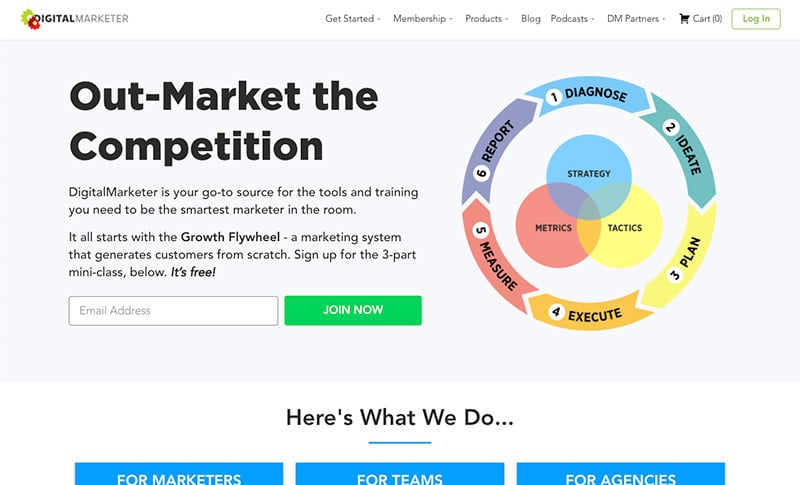
Pros: Generates recurring monthly revenue and creates engaged members.
Cons: It takes a while to ramp up to any significant revenue.
This business model is one is my favorites, and I’ve done quite well with it.
Along with Investor Junkie, I owned a web-hosting business. This technically fell under software as a service (SaaS).
As opposed to the typical one-time sale of a digital product, with SaaS, you have reoccurring revenue. In 2008, without that reccurring revenue, I would have been dead in the water.
Instead of having revenue that resets every month — as with other business models — with SaaS, you earn a monthly income from your subscribers. It’s the type of business that starts slow but then speeds up like a rocket ship once its momentum starts.
For more information on this, check out my article on how to set up a membership site on WordPress.
The problem with monetization is that it takes a while to grow your MRR (monthly recurring revenue) to support yourself. Unless you have a clear vision, I recommend not making this your primary way to make money blogging. Instead, look at it as one part of a bigger picture.
8. Physical Products
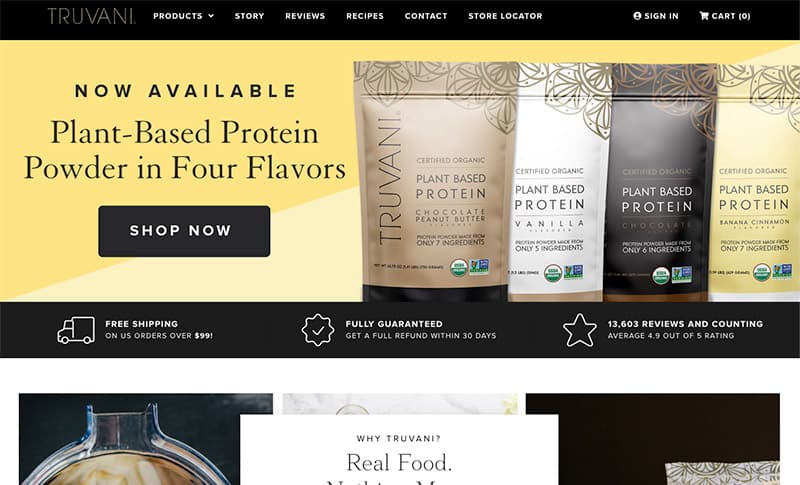
Pros: Much harder to copy than digital products.
Cons: Requires inventory and is not unlimited with scale. There is a fixed cost per item produced.
This could be selling your own or someone else’s products.
A common option is using Amazon’s FBA program. Since we are talking about blogs, if you’re interested in selling products, you must also have your own storefront for another source of traffic and revenue. WooCommerce is a good option if you like using WordPress.
The next level up is to drop-ship a product. You hold no inventory, nor do you have to ship the products yourself. Instead, you accept customer orders and another party in the supply chain ships out the product.
Many services will do this for you, and it’s a nice way to start out. Of course, the issue is that you have no control over costs other than switching vendors.
I’m not a fan of selling physical products, but I have quite a few friends who do very well with this model. If you’re considering going down this avenue, I recommend finding a similar product and offering it to your audience via an affiliate link.
The downside to physical products is that, unlike digital products, they aren’t infinitely scalable. You have to deal with COGS (the cost of goods sold). While you might be able to improve your margins as you sell more, there’s a fixed cost.
My Recommendations
If I were you, I would diversify my revenue and create a mixture of some (or all) of the eight options. As with any business, relying on just one source of revenue is a recipe for disaster.
The Best Options To Make Money Blogging:
- Consulting
- Affiliate marketing
- Digital products
Only once you build out an audience should you consider creating a membership site or SaaS product.
Again, your niche might be unique. But for most niches, these are the best options available.
